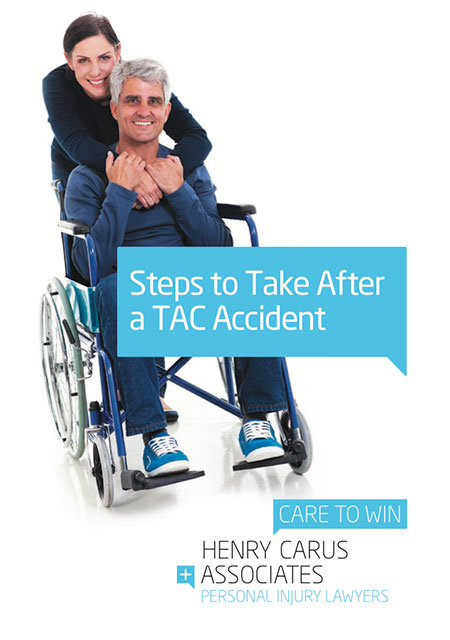
When you have suffered serious injuries caused by the negligence of someone else, you may be entitled to Common Law compensation.
Although the TAC will provide you with benefits right away, it can also later contest who is responsible for your accident. TAC does so as it also acts as the insurance company for the driver involved in your accident.
It is an aspect of the TAC compensation process that can be unsettling to a TAC client, as they have up to that point usually had the cooperation of the TAC.
We recently settled a matter for a client who fortunately was prepared for the TAC’s challenge on fault and we were prepared to advocate for him.
BACKGROUND OF THE CASE STUDY
One night our client and his colleagues made plans to go to the local pub. They arranged for a designated driver to avoid any issues.
On the way home the driver was speeding and failed to make a left turn striking a guard rail before eventually hitting into a tree. The car was overloaded and it was found that our client did not have his seatbelt on.
Unfortunately, one of the young passengers died as a result of the accident. Our client and one more passenger sustained serious injuries.
The ambulance and police attended the scene and after police investigations it was found the “designated” driver was way over the .05 limit and on top of this he was also unlicensed.
Soon after our client’s injuries stabilised he sought our advice with regard to his TAC claim and whether we were able to assist with a potential common law claim.
We were confident we could achieve a good result for the client and started working on his matter immediately.
COMMON LAW
Before seeking common law compensation you must be granted you a Serious Injury Certificate.
Our client suffered extensive serious injuries which had serious consequences on his life. He was granted a Serious Injury Certificate and the next challenging step was to show the accident was the fault of the driver.
As such, we sued the driver who was in jail. We said the injuries our client sustained were as a result of the driver’s negligence.
TAC’S ARGUMENTS
The TAC formed the view that our client was to blame for his extensive injures and prepared two arguments to support their view.
The TAC’s first argument was that our client knew or should have known the “designated” driver was drunk and that by getting into the car he accepted the risk that came with it. This is known as the “Voluntary Assumption of Risk” Defence.
In cases where this Defence is successful, the injured person would not be entitled to any compensation.
However, if that argument was to fail the TAC had an alternative argument. The TAC argued that if our client was not completely at fault, he contributed to his own injuries because he was not wearing a seatbelt and because he was in a car which was overloaded. This Defence is known as “contributory negligence.”
Contributory negligence occurs when you are found to have contributed to your loss or injury.
The amount of compensation can be reduced according to the extent you are found to have contributed to your loss.
WHAT WE DID AS TAC LAWYERS
In matters such as these, it is imperative to have an experienced and knowledgeable lawyer on your side to maximise your result. Cases such as these require in depth review and intelligent action.
When we reviewed the matter we immediately obtained the police brief to review all evidence against the driver. The brief contained all statements and expert reports arising immediately after the accident. In addition to this, we also conducted our own investigations on the accident circumstances.
The information we obtained was crucial as it indicated that our client did not see the driver drinking and that to the best of his knowledge the designated driver was not drunk.
This evidence would eventually prove to be very helpful in countering the TAC’s arguments. In an effort to maximise our client’s compensation we organised several medical examinations and obtained extensive medical evidence to clearly identify all of our client’s injuries and all consequences arising from them.
We also noted that as a result of the accident our client was no longer able to work in his pre-injury work capacity. He had hopes and dreams of owning and working in his own bakery. Unfortunately, after his accident and as a result of his injuries he was no longer able to work his pre-injury job. Rather, he could now only work on moderate to light duties as a storeperson.
We took this into account when calculating our client’s potential compensation. We found our client was earning less than what he could have earned if he stayed in his pre-injury position.
Prior to going to Court and in an effort to resolve the matter a conference was scheduled with the TAC.
NEGOTIATIONS
Before attending any conference or mediations our mindset is to always be prepared as if we were going to trial. There is always the chance, especially in complex matters such as these that the matter does not resolve.
However, on the basis of our evidence and our presentation the TAC quickly dropped their first argument and concentrated all its effort on the second argument.
The TAC conceded that their argument about our client being completely at fault for his own injuries would likely fail in Court.
On the second point, the TAC believed that there was at least some fault on our client’s part. On reflection, this was a fair argument, but with that being said, a good lawyer will need to carefully assess what would be a fair reduction on your total compensation. This is where our research, preparation and investigations really benefit our clients.
The discussions with the TAC were very lengthy and there was a lot of back and forth in terms of contributory negligence and a final settlement figure.
SETTLEMENT
Eventually, after a 35% reduction was applied we settled our client’s matter for $300,000.00.
Our client advised considering all of the circumstances, the settlement amount he received was more than he expected.
The other seriously injured passenger in the same vehicle was with another firm, and the TAC essentially had the same arguments against him, but he was found 60% liable.
Where matters such as this are not reviewed carefully, the difference in compensation can be significant.
Therefore, it is evident, especially in matters where the TAC contests who is at fault for your injuries to contact a specialist law firm such as Henry Carus + Associates as soon as possible.
You can rest assured that our team will take all necessary steps to maximise your compensation because YOU DESERVE MORE.
 Call Us Today
Call Us Today



